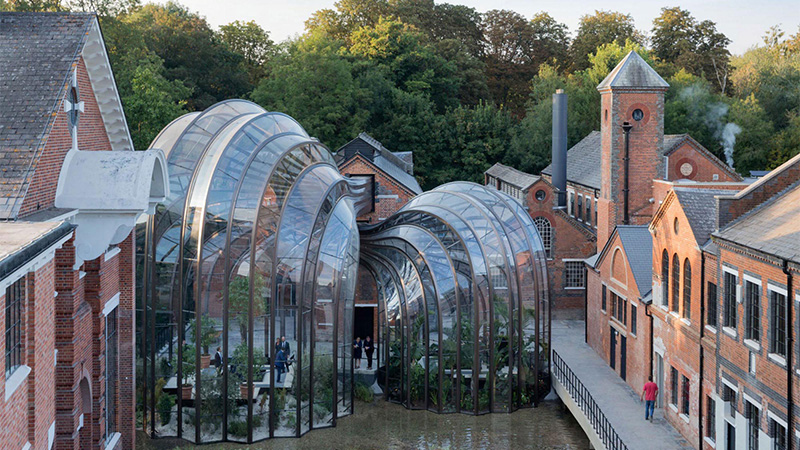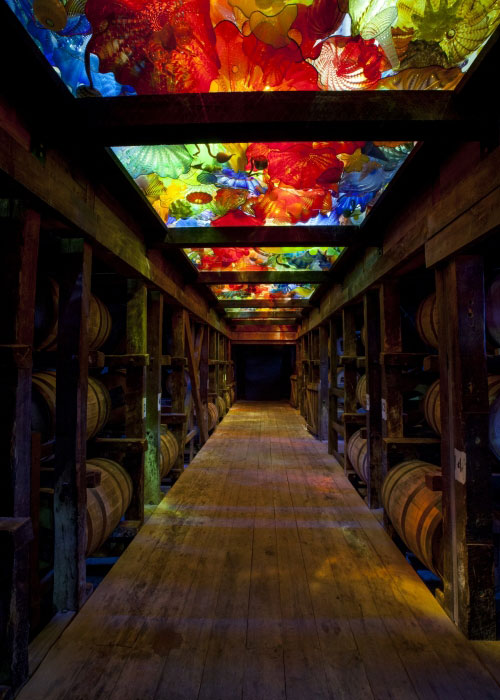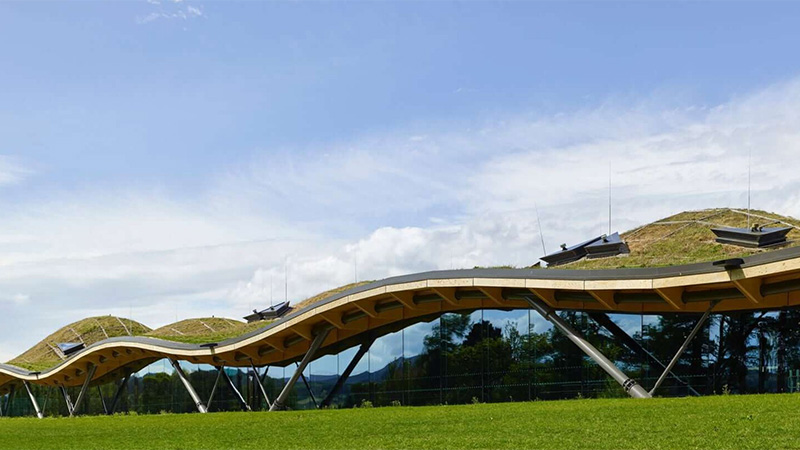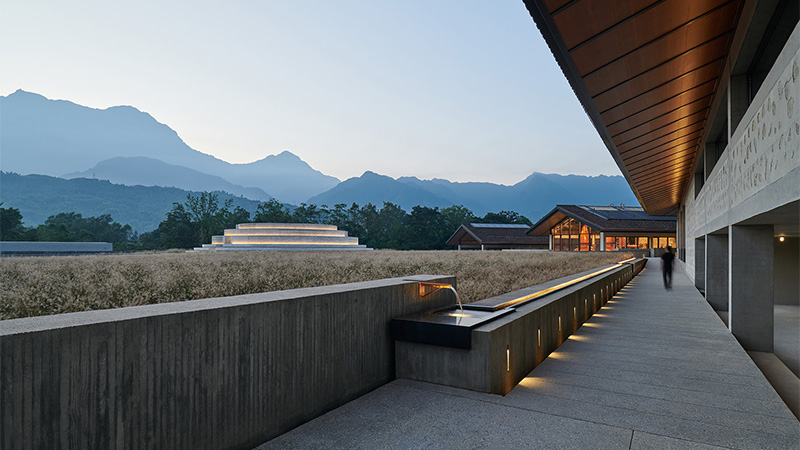A distillery visit includes everything a drinks enthusiast can wish for, including samples and tours, and often the opportunity to come home with exclusive releases or swag. And, of course, there’s the world class-art on display. What world-class production facility would be complete without that?
While there’s no denying the artistic merits of a well-aged whiskey or the pristine botanical profile of your favorite gin, distilleries are now bringing that sense of creative expression to the forefront, with arts installations that serve as standalone attractions as much as the liquid being served.
With Big Budgets Come Splashy Arts Investments
When Bombay Sapphire purchased the historic Laverstoke Mill in 2010 to serve as its production site, and eventually its visitor’s center as of 2014, it developed sustainability initiatives to take care of the surroundings, and preserved the legacy of the grounds by restoring its existing heritage structures. Then Bombay took a swing for the modern fences with a pair of structures christened Glasshouses designed by the architectural firm Heatherwick Studio. The flowing curves of the two glass greenhouses resemble copper pot stills, while housed within them are thriving ecosystems including the botanicals used to produce its gin, split between tropical and Mediterranean climates.
Don’t Miss A Drop
Get the latest in beer, wine, and cocktail culture sent straight to your inbox.
“The presence of all 10 botanicals in our Glasshouses visually showcases the intricate flavor profile of our liquid and serves as a constant source of inspiration for future iterations to come,” says Sam Halsall, the sales and marketing manager for parent company Bacardi’s U.K. brand homes division. “This visual display not only ignites the team’s creativity but also sparks the imagination of every visitor, encouraging us all to envision what exciting possibilities might unfold next.”

Bombay Sapphire attracts about 50,000 visitors per year, and this eye-catching architectural achievement is a core piece of the puzzle. “We have a lot of visitors who are interested in the architecture of the Glasshouses, as well as the rich history of the entire distillery at Laverstoke Mill,” Halsall says. “Everyone raves about how impressive the Glasshouses are in real life.”
“[An art installation] adds depth, it deepens the meaning and understanding of this unique location and land, and it’s another layer to experience the authenticity and the vision of our founders and the brand.”
It’s the type of play that a major international brand can make in an effort to bring more people through the doors, and Bombay Sapphire is far from the only distillery letting its creative juices flow.
Perhaps the most well-known stateside example of a distillery making a name for itself in the arts space is Maker’s Mark. Its Loretto, Ky., home is among the most bucolic and charming settings in the bourbonsphere, but don’t make the mistake of thinking it’s all about that aw shucks! Southern hospitality. There’s also a series of large-scale installations from renowned glass artist Dale Chihuly, including a stunning ceiling dubbed The Spirit of the Maker, commissioned in 2014, with the vivid color display flipping the notion of a dusty, dingy barrel warehouse on its head.
“As we often say to our visitors, we’re not here for a manufacturing tour, we’re here for an experience, and our art installations are an important part of that experience,” says Rob Samuels, eighth-generation whisky maker and grandson of the founders at Maker’s Mark. “It adds depth, it deepens the meaning and understanding of this unique location and land, and it’s another layer to experience the authenticity and the vision of our founders and the brand.”
Maker’s Mark recently unveiled its Homeplace Gallery, with a collection of modern art geared toward sustainability and protecting the natural environment. “It’s a gorgeous example of the interplay between nature and art,” Samuels says. “As an agricultural product, our founders celebrated nature through Star Hill Farm and purchasing the property, and I am always thinking about how we continue that journey in a way that is true and authentic to the brand.”

That homey, personal touch is a real thing at Maker’s Mark, and the art displays only add to it for the 125,000 visitors who make the trek each year. “Margie Samuels always said that a visit to Star Hill Farm needs to feel personal, and we think that the art and atmosphere appeals to folks in a very personal way,” Samuels says.
For a brand the stature and size of The Macallan, it was inevitable that its new distillery would be an exemplary achievement representative of its luxury appeal. The Rogers Stirk Harbour + Partners project cost about $186 million, with its sunken positioning and undulating, green rooftop ensuring it blends into the environs of its 370-acre site.

The distillery opened in 2018 following a three-and-a-half-year build-out, with a showpiece stillhouse and a number of engaging exhibits and displays. Its rooftop is touted as the most complicated structure of its type in the world, consisting of more than 380,000 individual components. “When inside, the natural materials such as local stone and timber, coupled with the thoughtful landscaping design, not only evoke the environment and ingredients of whisky production but serve to provide an atmospheric journey for our guests,” says Stuart Cassells, general manager of The Macallan Estate.
The distillery attracts 22,000 visitors per year with a range of experiences, and recently took home honors via the Architecture Today Awards. The judges noted that it’s “an epic creation of cathedral-like proportions that somehow manages to sit unobtrusively in its landscape.”
Pernod Ricard decided to embark on a new chapter of whisky distillation in China, and it knew making a splash was a necessary part of the puzzle. No expense was then spared in the construction of its new $150 million The Chuan whisky distillery in Sichuan province. The concept blends modern and traditional Chinese architecture, with the distillery explaining that its core philosophy is the dichotomy of two opposing elements that complement each other.
“Two people can look at the same piece of art, one falling in love with it and the other not understanding it. The same is true for spirits.”
When the distillery broke ground in 2019, Chivas Brothers chairman and CEO Jean-Etienne Gourgues explained that it aimed to attract 2 million visitors per year. “Tourist interest is one of the key factors we considered when we decided to put our first Chinese whisky distillery in Emeishan,” Gourgues, who was then the managing director of Pernod Ricard China, told me at the time. (Chivas Brothers is essentially the Scotch whisky wing underneath parent company Pernod.) The distillery was designed by the Chinese architecture firm Neri&Hu, and is home to a permanent collection from sculptor Zhan Wang. “A spirit is more than a drink, it’s a cultural product,” Gourgues said.
Arts & Craft Distilleries
Craft brands are attacking the arts in a different way. For one in particular, it’s its entire ethos. The Distillery of Modern Art in Chamblee, Ga., is one part modern art gallery, one part distillery and cocktail bar. Established in 2021, the venture was always intended to bring founder Seth Watson’s passion for modern art and spirits together. “It became evident to me that art and spirits are highly subjective matters,” he says. “Two people can look at the same piece of art, one falling in love with it and the other not understanding it. The same is true for spirits.”

Watson didn’t want the distillery to pretend to be anything it wasn’t. “None of us are fifth- generation distillers, and we don’t have some just-discovered, 200-year-old recipe,” he says. “Fresh eyes, a new perspective, and an open mind will allow us to be creative without boundaries.”
Its gallery is an opportunity to give back to the local arts scene, offering a place to showcase work without taking a commission from the artists for sales. “We want a real relationship with these artists, not so that we can make a little money on the side,” Watson says. “This, in return, gives us ever-changing décor, a reason for guests to come back time after time and experience something new.”
For Great Jones Distilling Co. in Manhattan, it made sense to tap into the city’s artistic vibrancy. Earlier this year, the distillery debuted a collection of three bottles featuring artwork from Jean-Michel Basquiat, whose studio was located down the block from where the distillery now resides. In tandem with the bottles came activations such as a Basquiat Speakeasy Art Exhibit event, a pop-up Basquiat Bar, and a collection of co-branded merch.
“The most significant connection we make is that, just like with art, when we make a new spirit, we think just because it was done this way before, why do it the same now?”
Whether on a craft or mega scale, a distillery’s investment in the arts work best when there’s an authentic connection between those two realms. “Our north star for everything is asking, ‘How do you move into the future and stay true to who you are, ensuring that the Maker’s Mark DNA is woven through everything?’” Samuels says. “Dale Chihuly in particular has been an inspiration to me and to the brand. Much like my grandparents did 70 years ago when they started Maker’s Mark, his approach is one of innovation and shaking up the status quo.”
From there, the distillery’s emphasis on art with a connection to the environment was a logical step. “After all, whisky is nature distilled, and our higher purpose as a brand is to understand, protect, and share our land in a way that will benefit not only our generation, but many more generations in the future,” Samuels says.
At the Distillery of Modern Art, it should come as no surprise that there’s a through line from the art on the wall to the spirits in the bottle. “The most significant connection we make is that, just like with art, when we make a new spirit, we think just because it was done this way before, why do it the same now?” Watson says.
The next time you visit a distillery, you’ll probably be coming home with a bottle of something special, but perhaps also a memory of an inspirational piece of art, an unforgettable sculpture, or an astounding architectural design. It may even prove worthy of posting to the feed. “The Glasshouses stand as our signature attraction, a picturesque moment that captures the essence of the distillery,” Halsall says. “These stunning structures are our Instagrammable centerpiece and help showcase the entire creation of Bombay Sapphire.”
Because your distillery visit didn’t happen unless the social masses saw your killer content, right? I know my 47 followers would agree.
This story is a part of VP Pro, our free platform and newsletter for drinks industry professionals, covering wine, beer, liquor, and beyond. Sign up for VP Pro now!


